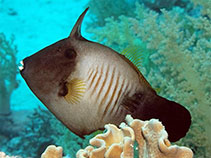| Family: |
Monacanthidae (Filefishes) |
| Max. size: |
20 cm TL (male/unsexed) |
| Environment: |
reef-associated; marine; depth range 0 - 18 m |
| Distribution: |
Indo-Pacific: Red Sea south to Maputo, Mozambique (Ref. 4421) and east to the Society and Tuamoto islands, north to the Gotô Islands, Japan (Ref. 559), south to the southern Great Barrier Reef. |
| Diagnosis: |
Dorsal spines (total): 2-2; Dorsal soft rays (total): 26-29; Anal spines: 0-0; Anal soft rays: 22-25. Body brown with up to 12 narrow dark brown crossbars; caudal fin dark brown; soft dorsal, anal and pectoral fins pale; lips dark brown (Ref. 4421). Males with numerous long spines in front of caudal peduncle; females with a toothbrush-like mass of setae (Ref. 1602).
Description: Characterized further by having nearly straight first dorsal spine, about equal to length of snout; straight to slightly concave dorsal profile of snout; relatively deep caudal peduncle, depth about equal to caudal fin length; depth of body at anal fin origin 1.9-2.1 in SL (Ref. 90102). |
| Biology: |
Inhabits clear coastal to outer reefs, usually in rich coral areas with rubble patches or gutters (Ref. 48637). Feeds on coral polyps (Ref. 89972). Solitary or in pairs (Ref. 90102). Less approachable than most filefishes (Ref. 9710). Usually seeks coverage in large corals when approached (Ref. 48637). Minimum depth reported taken from Ref. 128797. |
| IUCN Red List Status: |
Least Concern (LC); Date assessed: 03 March 2015 Ref. (130435)
|
| Threat to humans: |
harmless |
Source and more info: www.fishbase.org. For personal, classroom, and other internal use only. Not for publication.
